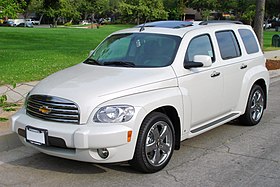Chevrolet HHR
| Chevrolet HHR | |
|---|---|
 |
|
| Overview | |
| Manufacturer | Chevrolet (General Motors) |
| Production | 2005–2011 |
| Model years | 2006–2011 |
| Assembly | Ramos Arizpe, Coahuila, Mexico |
| Designer | Bryan Nesbitt |
| Body and chassis | |
| Class | Compact Car |
| Body style | 5-door wagon 5-door panel van |
| Layout | Transverse front-engine, front-wheel drive |
| Platform | GM Delta platform/GMT001 |
| Related |
Chevrolet Cobalt Pontiac G5 Saturn Ion |
| Powertrain | |
| Engine | 2.2 L (130 cu in) Ecotec L61 I4 2.4 L (150 cu in) Ecotec LE5 I4 2.0 L (120 cu in) I4 turbocharged Ecotec LNF |
| Transmission | 5-speed F35 (MU3) manual 5-speed Getrag F23 manual 4-speed 4T45 automatic |
| Dimensions | |
| Wheelbase | 2,630 mm (104 in) |
| Length | 4,475 mm (176.2 in) SS: 4,480 mm (176 in) |
| Width | 1,755 mm (69.1 in) |
| Height | 1,605 mm (63.2 in) SS: 1,590 mm (63 in) |
| Chronology | |
| Successor |
Chevrolet Captiva Sport Chevrolet Traverse(US) Chevrolet Trax (Canada, US from 2015 Model Year) Chevrolet Orlando (Canada) Chevrolet City Express (panel van) |
The Chevrolet HHR is a retro-styled, high-roof five-door, five-passenger, front wheel drive station wagon launched by Chevrolet at the 2005 Los Angeles Auto Show as a 2006 model — and designed by Bryan Nesbitt.
The HHR shares the GM Delta platform with the Chevrolet Cobalt, Pontiac G5, and Saturn Ion. In Mexico, it was marketed with its predecessor, the Opel-sourced Chevrolet Zafira compact MPV.
Chevrolet marketed a panel-van variant of the HHR beginning in 2007. Assembled in Ramos Arizpe, Mexico and marketed throughout North America, production of the HHR ended in May 2011.
The name HHR is an acronym for Heritage High Roof.
The vehicle's design was inspired by the mid-1940s Chevrolet cars and trucks, specifically the 1947 Chevrolet Suburban and Advance Design pickups, with large, square fender flares and a hemispherical grille. The design of the HHR has been credited to Bryan Nesbitt who was a former designer at Chrysler where he was the lead designer of the Chrysler PT Cruiser. Nesbitt was recruited by GM to join its design staff and served for a time as the chief designer of the Chevrolet brand. The HHR had a cargo-carrying capacity of 62.7 cubic feet (1.78 m3). All models had a flat-load floor (passenger models have 60/40 split bench) and fold-flat front passenger seat. For the 2007 model year, it was available in five trim levels; LS, LT, 2LT, and Special Edition. A panel van variant was also made available in 2007 for only the LT trim and became available on all trim levels in 2008.
...
Wikipedia
